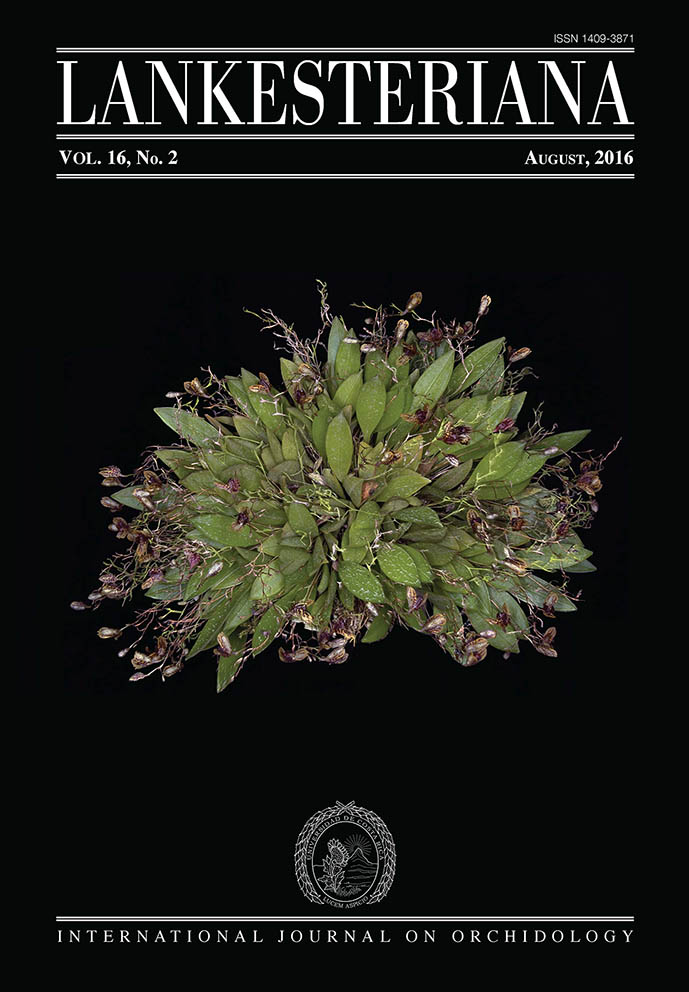Recent advances on evolution of pollination systems and reproductive biology of Vanilloideae (Orchidaceae)
DOI:
https://doi.org/10.15517/lank.v16i2.26010Keywords:
Flower reward, food deception, Pogonieae, pollination biology, reproduction, VanilleaeAbstract
Vanilloideae as currently circumscribed comprises nine genera and two tribes: Vanilleae and Pogonieae. The pantropical genus Vanilla has been frequently assumed to be natural on the basis of its climbing habit and lateral inflorescences. However, the inclusion of the rare Dictyophyllaria dietschiana in phylogenetic analyses makes the genus Vanilla paraphyletic. Within Pogonieae, phylogenetic analyses show that inclusion of Pogoniopsis turns the tribe paraphyletic. All analyses reveal that Pogoniopsis is closely related to members of Epidendroideae. Members of Pogonieae are pollinated by several groups of solitary and social bees, two pollination systems being recognized: reward-producing and deceptive. Molecular phylogeny suggests that the common ancestor to Pogonieae gave rise to two evolutionary lineages: one tropical with a condition of reward production; and one predominantly temperate-invading line with deceptive flowers. Reward-producing flowers characterize South and Central American clade (= Cleistes), while deceptive pollination is prominent in the clade including North American-Asiatic taxa plus Amazonian Duckeella. Species of “orchid bees” have been recorded as pollinators of the genus Vanilla (V. planifolia group and V. pompona group) in the Neotropics. In species of the V. pompona group, these bees are attracted by the fragrance of the flowers. Hummingbirds have been reported to pollinate some species of Vanilla. Vanilla insignis, V. odorata and V. planifolia are known to be pollinated through generalized food deception. Some species of Vanilla yield fruits through spontaneous self-pollination. This form of autogamy has been reported for V. griffithii, V. palmarum, V. planifolia, V. savannarum and V. bicolor. In Brazil, data on the pollination biology of Vanilla are scarce, but conclusive data are available for V. edwallii, which is pollinated by Epicharis (Apidae: Centridini). This species is rewardless, but male Epicharis are attracted to its flowers by their fragrance. Additionally, the Brazilian V. dubia and E. sclerophyllum are pollinated by bees. The mentum region of V. dubia and V. edwallii is dry, whereas that of E. sclerophyllum presents a small quantity of nectar. Flowers of E. sclerophyllum are scentless, while those of V. dubia are odoriferous. Vanilla dubia and V. edwallii are self-compatible and need a pollinator to yield fruits. In contrast, Epistephium sclerophyllum sets fruits through spontaneous self-pollination, but biotic pollination also occurs. Both species are primarily adapted to pollination by euglossine bees. Pollination by Euglossini seems to have evolved at least twice along the evolution of Vanilleae. Furthermore, shifts between rewarding and rewardless flowers and between autogamous and allogamous species have been reported among vanillas.
Downloads
Downloads
Published
How to Cite
Issue
Section
License
According to the Open Access policy promoted by the University of Costa Rica, all the papers published by Lankesteriana are licensed under the Creative Commons copyright and can be downloaded free of charge. The journal holds copyright and publishing rights under the CC BY-NC-ND 3.0 CR license.
Before the publication of the materials submitted by the author(s) in LANKESTERIANA, the author(s) hereby assign all rights in the article to the Lankester Botanical Garden.





